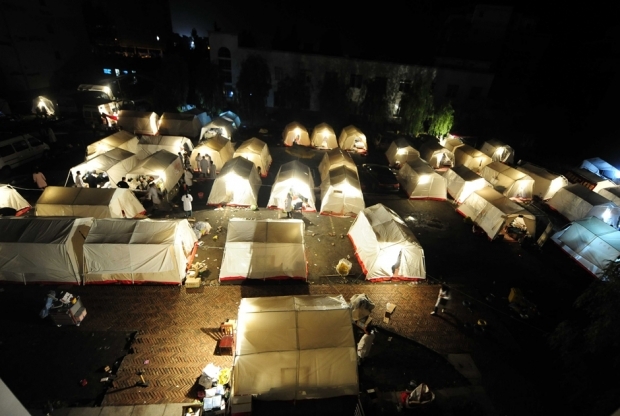China’s social media was in mourning yesterday as users turned their profile photos to grey in remembrance of the victims of the 7.0 earthquake that struck the Ya’an region in Sichuan province on Saturday. As of April 22, the death toll has risen to 192.
The Ya’an earthquake is the most serious natural disaster to hit China since the onset of its social media age in 2009. Most Internet users still have vivid memories of the 2008 Wenchuan earthquake, when China Central Television (CCTV) dominated reporting. This time, within two days of the Ya’an earthquake, millions of tweets were posted on China’s active microblogs like Sina Weibo and Tencent Weibo, and it is clear that things are different.
Social media reaction to the earthquake is instant. Immediately after the official Chinese Earthquake Channel (@中国地震台网) confirmed the earthquake one minute after it struck on the morning of April 20, China’s leading microblogging platforms became busy as users shared information and tweeted about the latest news from the disaster zone.
The opinion leaders on microblogs, some of whom have millions of followers, used their influence to broadcast rescue requests. Zuoyeben (@作业本), one of the most popular grassroots microbloggers with 5.6 million followers, simply tweeted: “If any of my followers is waiting for rescue or have not been contacted, if you see this tweet, you can immediately send me a message via microblog, I’ll tell you my account and password and you can tweet rescue message from my account.”
A few hours after the disaster, Google China made a person-finder search engine for the Ya’an earthquake similar to the one used in the aftermath of the Boston marathon bombing. Major Chinese searching engines, including Baidu, Sohu, and 360, quickly followed suit.
Users shared news from the front lines of search and rescue. For example, when the main roads into the disaster zone were blocked by traffic, many tweeted messages asking volunteers not to enter the area to allow better access for professional rescuers.
Luqiu Luwei (@闾丘露薇), a well-known television journalist, commented on the contrast between traditional media and social media, in her Weibo account, “Just watched some live reporting from front-line journalists and couldn’t get key information like what the most urgent needs are on the ground. [They are] less professional than information on Weibo.”
While millions of users shared useful information, expressed their well-wishes and encouragements, and initiated fundraising campaigns, some users are have also taken this opportunity to question official conduct. After he heard that thousands of soldiers from the People’s Liberation Army were sent to the quake zone for search and rescue missions, Ye Gongmo (@叶恭默), an IT company manager, questioned the military’s intentions:
The primary mission of the army and police is to control the site and monitor the situation, search and rescue come second. First of all, [the government] is worried that the anger would shift and the situation would spiral out of control; secondly, they are afraid that civil society would develop; thirdly, they can gain valuable moral authority through search and rescue efforts; and fourth, they can bury the evidence of potential official wrongdoing that may have exacerbated the destruction caused by the natural disaster.”
His post was widely circulated and reposted, with many users criticizing his cynicism, but it was soon deleted by censors. Ye’s later tweets revealed that, “this tweet brought me troubles. There are people looking for me.”
China’s Red Cross (the government-affiliated charity still reeling from scandals) was again in the middle of the debate, with Internet users criticizing its workers for posting a photo of themselves taking a break during an intense search and rescue period.
Indeed, people are casting votes of no confidence on the Red Cross with their wallets and turning to China’s increasingly active civil society. The One Foundation, the private charity started by Jet Li that emphasizes transparency and accountability, is a popular alternative. Luo Changping (@罗昌平) tweeted: “Earthquake donations shifted from Red Cross to One Foundation—the people have voted five years after [the 2008 earthquake].”
Other users have focused on the role of China’s tightly controlled traditional media in disaster coverage, asking reporters to stop “kissing high officials’ ass” and be more sensitive when interviewing victims. And China’s usually staid traditional media is heeding the calls from the Internet. When CCTV interviewed the local party secretary, the anchor interrupted the official’s long-winded speech and asked him to cut to the chase and talk about the rescue efforts. The anchor’s gesture won much praise in social media, from 45,000 microblogs in Sina Weibo alone.
Unfortunately, social media has also become the playground for fraudsters and rumor-mongers after the disaster. Millions of tweets discussed fake fundraising accounts, fake donations from celebrities, and the possible fake reporting from a journalist in her wedding dress.
At the end of the day, what microblog users are demanding is a more transparent system that can better help the victims. As the editorial staff of Southern Metropolis newspaper (@南都评论) put it: “A transparent society that offers individuals enough freedom will have enough confidence to resolve all unnecessary anxieties.”




